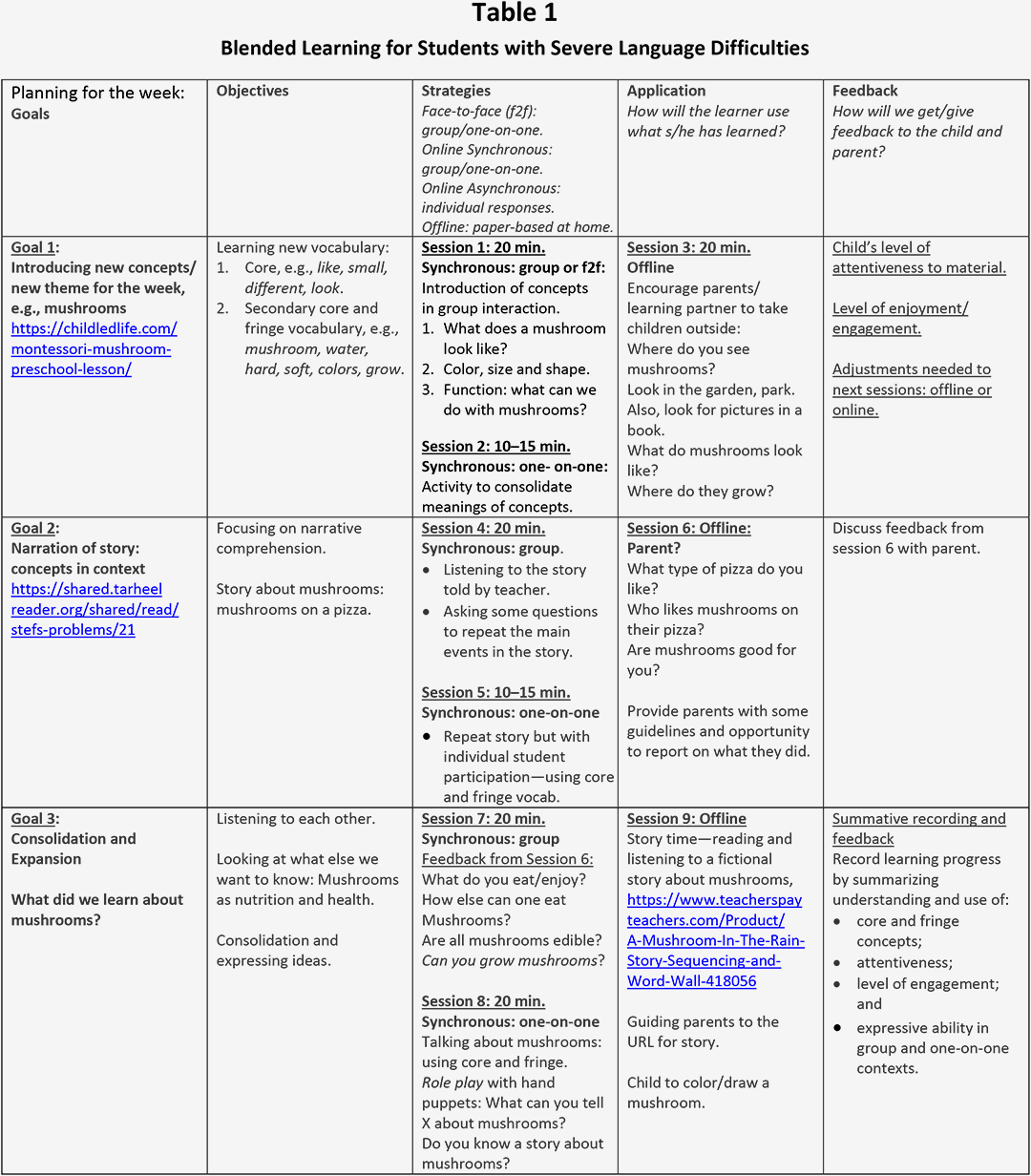I remember when I first started to teach online in the late ’90s, I attended a training session on blended learning. The message was that online learning is not “just like classroom learning.” You cannot take what you do in face-to-face classroom teaching and simply put it “online.” You need to identifythe main purpose of the learning exposure, and then select the strategy best fit to achieve the goal. One has to integrate learning purpose and strategy from the get-go.
This integration requires that one has knowledge and understanding of the different types of online strategies, their strengths, and their limitations. There are no hard and fast rules for what strategies work best for students with severe communication difficulties. The secret to success is: one needs to be open-minded in observing each student’s pace of learning and adapt strategies to suit the student’s learning outcomes.
For example, the best way to introduce a story might be in a synchronous group online or classroom situation. However, tapping into the children’s understanding of the story could be more effectively done via an individual one-on-one session, whether online or face-to-face. Thereafter, parents can facilitate re-enactment of the story to consolidate information learned. If parents are uncomfortable with this level of participation, we need to adjust the strategies used.
Parent participation
All parents are not be able to support their children’s learning efforts to the same extent. Teachers and therapists need to collaborate with parents about how parents can realistically support their children’s online learning. The art is to involve parents in a way that allows them to build on their relationship with their child. The more upfront thinking we put in to find ways to guide parents on how to participate in their child’s learning, the more likely it is that they will support our intervention efforts.
Parents need to know that they have a voice in structuring the blended learning environment. This process starts by making sure parents understand our goals and session plans by sharing information with them (e.g., see Table 1 below). Parents need to develop the freedom to use what we offer and expand on the theme to enrich their child’s knowledge and experience surrounding the topic. Expanding world knowledge of our students is one of the most critically important issues in the development of language and communication skills.
Blended and Hybrid Learning
Although hybrid and blended learning seem like the same concept, and are often confused, there is a subtle yet important distinction. Blended learning focuses on the combination of offline and online instruction. Hybrid learning seeks to promote the best experience for individual students which include a variety of online strategies (e.g., synchronous or asynchronous strategies).
It is easy to get distracted by all the different models and ways of online teaching. The following questions are important in guiding us through the process:
- What parts of the lesson will be more effectively conducted in a face-to-face situation versus a synchronous or asynchronous online context?
- Should we use group or individual interactions—and how will we do this?
- How will feedback be given to the student—and how will the student give feedback to the teacher? We need to ensure that we have a continuous flow of interaction with the parents.
An example:
Integrated sessions using blended learning for students with severe communication difficulties
Table 1 outlines nine small sessions or lessons based on one theme, i.e., Mushrooms. Teachers can take these ideas and change them to suit their particular teaching goals.
Table 1:
Blended Learning for Students with Severe Language Difficulties

 The topic was selected because it is relatively easy to find mushrooms in gardens and parks at this time. This is an added benefit in stimulating the students’ interest in exploring different sizes and types of mushrooms.
The topic was selected because it is relatively easy to find mushrooms in gardens and parks at this time. This is an added benefit in stimulating the students’ interest in exploring different sizes and types of mushrooms.
The idea is to entice the child to look for and talk about different aspects of mushrooms.
Explanation of Table 1
- The first column in Table 1 briefly outlines the main goals for a set of short lessons based on the theme, i.e., Mushrooms. It introduces the concepts (goal 1); applies these concepts within a narrative context (goal 2); and finally it consolidates and expands the concepts (goal 3). Parents need to feel free to expand the topic with their children.
- The second column introduces the objectives for the sessions by highlighting the core and fringe vocabulary selected by the teacher.
- Column three provides strategies for each of the lessons. I encourage teachers to use both group and individual sessions. Students need the opportunity of seeing and interacting with each other in both online and offline environments.
- The fourth column focuses on how to apply learning outcomes by encouraging parents to expand learning at home. As classroom teaching is more controlled, these lessons can often be quite repetitive and instruction-focused. Online learning, however, needs to emphasize application of the material we teach. We need to help students to stay on-target by spiking their interest to explore what they learn online or in the classroom to the home and other environments. We can pay specific attention to ways in which the students can apply the concepts by going for walks outside, getting parents to discuss topics with them, or introducing role-play activities in play situations. The key here is to get to know our students to guide us better in how to achieve this goal. Students learn when they enjoy what they do.
- The last column provides ideas on how to maintain a consistent flow of feedback (and data recording) to and from the student and parent. This system forms the backbone of successful blended learning. We need to record both the child’s level of engagement as well as participation and communication.
I hope these ideas encourage you to explore blended lessons for the new school year. This process requires that you make mistakes, learn from them—and move on! (Big smile!) As Mary Tyler Moore used to say, “Take chances, make mistakes. That’s how you grow!”
Have fun and let me know if you have any questions or comments!


